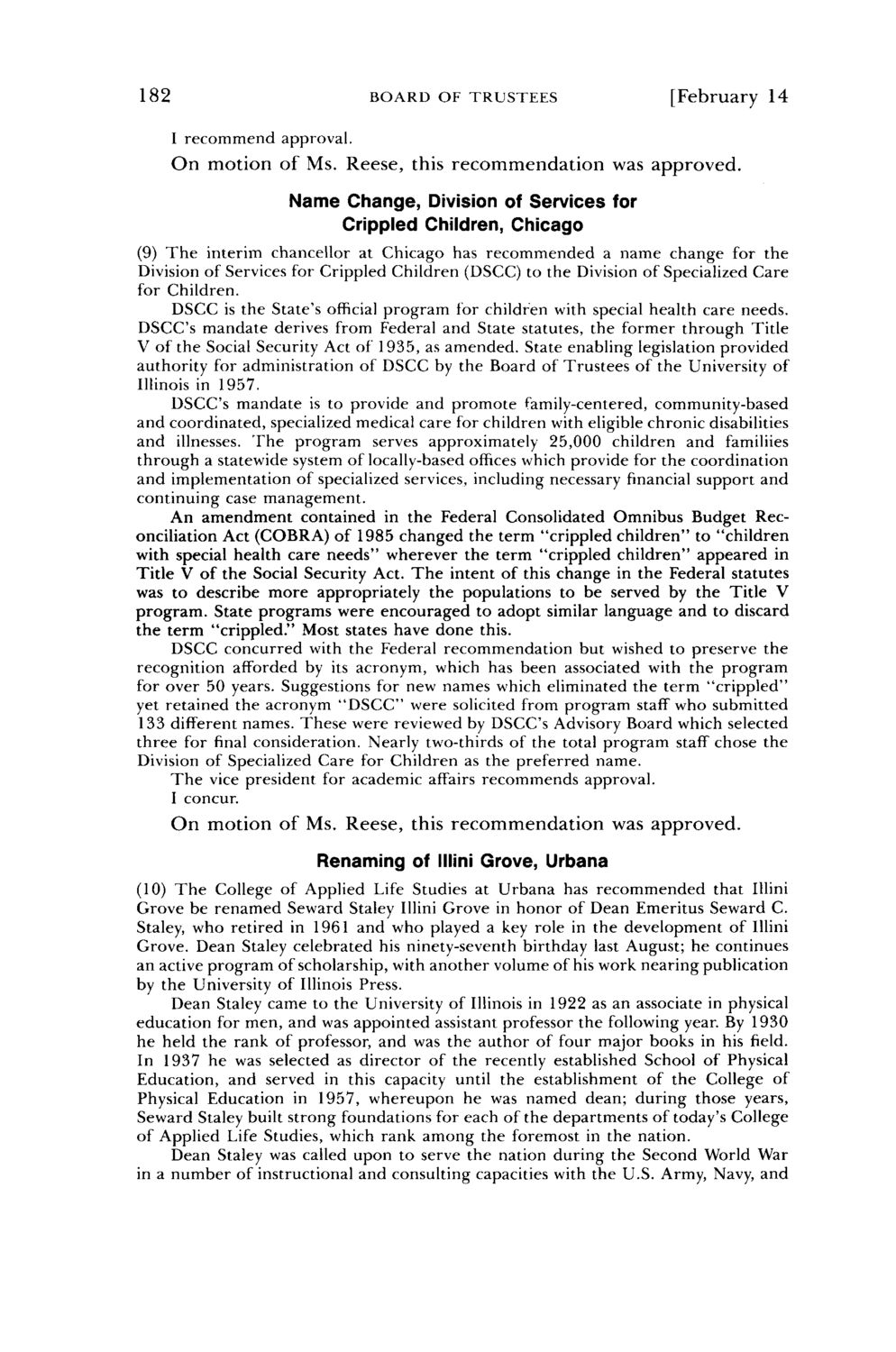| |
| |
Caption: Board of Trustees Minutes - 1990
This is a reduced-resolution page image for fast online browsing.

EXTRACTED TEXT FROM PAGE:
182 I recommend approval. BOARD O F T R U S T E E S [February 14 O n motion of Ms. Reese, this recommendation was approved. Name Change, Division of Services for Crippled Children, Chicago (9) T h e interim chancellor at Chicago has recommended a name change for the Division of Services for Crippled Children (DSCC) to the Division of Specialized Care for Children. DSCC is the State's official program for children with special health care needs. DSCC's mandate derives from Federal and State statutes, the former through Title V of the Social Security Act of 1935, as amended. State enabling legislation provided authority for administration of DSCC by the Board of Trustees of the University of Illinois in 1957. DSCC's mandate is to provide and promote family-centered, community-based and coordinated, specialized medical care for children with eligible chronic disabilities and illnesses. T h e program serves approximately 25,000 children and familiies through a statewide system of locally-based offices which provide for the coordination and implementation of specialized services, including necessary financial support and continuing case management. An amendment contained in the Federal Consolidated Omnibus Budget Reconciliation Act (COBRA) of 1985 changed the term "crippled children" to "children with special health care needs" wherever the term "crippled children" appeared in Title V of the Social Security Act. The intent of this change in the Federal statutes was to describe more appropriately the populations to be served by the Title V program. State programs were encouraged to adopt similar language and to discard the term "crippled." Most states have done this. DSCC concurred with the Federal recommendation but wished to preserve the recognition afforded by its acronym, which has been associated with the program for over 50 years. Suggestions for new names which eliminated the term "crippled" yet retained the acronym "DSCC" were solicited from program staff who submitted 133 different names. These were reviewed by DSCC's Advisory Board which selected three for final consideration. Nearly two-thirds of the total program staff chose the Division of Specialized Care for Children as the preferred name. T h e vice president for academic affairs recommends approval. I concur. O n motion of Ms. Reese, this recommendation was approved. Renaming of lllini Grove, Urbana (10) T h e College of Applied Life Studies at Urbana has recommended that lllini Grove be renamed Seward Staley lllini Grove in honor of Dean Emeritus Seward C. Staley, who retired in 1961 and who played a key role in the development of lllini Grove. Dean Staley celebrated his ninety-seventh birthday last August; he continues an active program of scholarship, with another volume of his work nearing publication by the University of Illinois Press. Dean Staley came to the University of Illinois in 1922 as an associate in physical education for men, and was appointed assistant professor the following year. By 1930 he held the rank of professor, and was the author of four major books in his field. In 1937 he was selected as director of the recently established School of Physical Education, and served in this capacity until the establishment of the College of Physical Education in 1957, whereupon he was named dean; during those years, Seward Staley built strong foundations for each of the departments of today's College of Applied Life Studies, which rank among the foremost in the nation. Dean Staley was called upon to serve the nation during the Second World War in a number of instructional and consulting capacities with the U.S. Army, Navy, and
| |